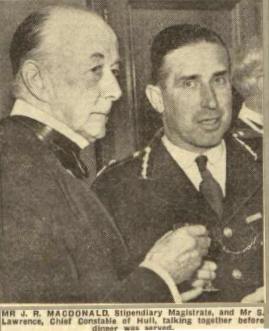A perennial problem cropped up on the first of June 1959. In a letter to the then Chief Constable of Hull Police, Mr. S. Lawrence esq. O.B.E. the problem was aired. That problem was vandalism.
The role of Cemetery Secretary at this time was held by the Company Solicitor Mr J.F. Payne of Payne and Payne, Solicitors. Here is the text of his letter.
The first letter
‘Unfortunately, the Company is almost impossible to supervise without a police force of its own, which the Company simply cannot afford to pay for and accordingly damage to grave stones and monuments is invariably reported late, which makes the job of the police force in detecting the miscreants, equally impossible.
We have, however, a fairly recent instance, some three weeks ago, where a smooth granite tomb has been interfered with and damaged, and accordingly we wonder whether it would be possible for any useful action to be taken by you on this recent complaint, but perhaps particularly, whether it would be possible to give the Cemetery just a little extra supervision by the beatman concerned for say the next three or four weeks.
If we may suggest it, as the gates of the Cemetery are now left open it might be possible for a beatman with a bicycle to ride through a portion of the Cemetery on his rounds. We think the most likely miscreants are teenagers.
We refer to the interference with a very smooth granite tomb. It does just occur to us that, if you felt the matter justified it, this might, even at this late date, bear some fingerprints of those responsible’
Naivety
The letter shows not only that vandalism was just as common then as now. So much for the ‘Good Old Days’
It also shows a rather touching naivety in the power of detecting criminals that the police may have. The request for a ‘beatman’, or a police officer on a bicycle, to ride through the Cemetery is perhaps a worthwhile approach. The taking of fingerprints from overturned headstones is quite laughable.
I suspect that this letter was sent more in hope rather than having a belief that action would be taken.
It also shows that the Cemetery was fast becoming derelict. This was a foretaste for the future and the decline of the Cemetery was already well established by the late 1950s.
The second letter
We have no way of knowing what the official response to this request was. Another letter of the 7th June 1960 to the Chief Constable showed that good may have come from the initial letter.
‘Dear Sir,
I understand that two or three of your officers have recently interviewed several youths in connection with damage done to trees and headstones in this cemetery.
It would be appreciated if you would forward to me copies of any statements obtained by your officers, or given by them, together with, if possible, any reported interviews.’
This letter shows perhaps a little naivety of legal proceedings, especially from a solicitor. He wanted access to police interviews and statements from people. These people had not been legally processed at that time.
However the letter also shows that some youths had been apprehended. So perhaps the initial letter had met with a positive response.
We have no further information on this intriguing line of inquiry. Sadly we do know that it did not end the vandalism there.

Pete Lowden is a member of the Friends of Hull General Cemetery committee which is committed to reclaiming the cemetery and returning it back to a community resource.


Things never change! Interesting article.
You’re right Bill. The damage to HGC didn’t just happen over the last few years but over about half a century. Sadly we aren’t old enough to have seen it at its best.
And still it happens today and not just by youngsters! Liked this article.
Thank you Brian